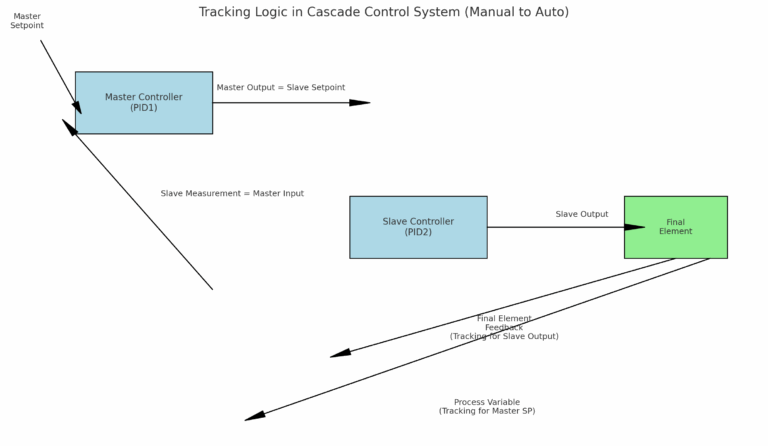In automatic control systems, achieving bumpless transfer is crucial. Bumpless transfer refers to the ability to switch between manual and automatic modes without introducing any disturbances into the process. Typically, switching from automatic to manual mode is straightforward. However, switching from manual to automatic mode is more complex and demands careful design.
1. Bumpless Transfer in Single-Loop Control Systems
For single-loop control systems, bumpless transfer is relatively easier to implement. It typically involves the following tracking mechanisms:
1.1 Controller Output Tracks the Final Control Element Feedback in Manual Mode
In manual mode, the controller’s computational output is ignored. Instead, its output is forced to match the feedback from the final control element (e.g., valve position). This is referred to as output tracking. When switching to automatic mode, the controller resumes computation, and its initial output is based on the last tracked value, with subsequent outputs being the accumulation (or integration) of real-time calculations.
1.2 Controller Input Includes Final Element Feedback
Although the feedback signal from the final control element is not significant during normal automatic operation, it plays a critical role at the moment of manual-to-automatic switching. It provides the initial baseline for the controller to begin integration and ensures continuity.
1.3 Setpoint Tracking to Process Variable in Manual Mode
During manual operation, the controller’s setpoint is forced to track the current process variable (PV). This setpoint tracking minimizes the deviation (error) to zero during manual mode. The goal is to eliminate sudden jumps in the control output due to pre-existing deviations when switching to automatic mode.
Why Setpoint Tracking Matters:
Without setpoint tracking, the controller still internally computes PID outputs during manual operation. Upon switching to automatic, these pre-computed values—especially from the integral term—can introduce significant disturbances:
Proportional action causes disturbance proportional to the error × gain.
Integral action accumulates over time, potentially introducing the largest disturbance.
Derivative action only activates if there’s a change in deviation at the switching moment, and is usually minimal.
Setpoint tracking eliminates this problem by keeping the deviation at zero, thereby minimizing all PID-related disturbances.
2. Bumpless Transfer in Cascade Control Systems
Cascade control systems involve both a primary (master) and a secondary (slave) loop, making bumpless transfer more complex.
2.1 Secondary Loop (Slave Controller)
In manual mode, the slave controller’s output tracks the final element feedback.
Its setpoint tracks its process variable to ensure zero deviation.
When switching to automatic, the controller uses the tracked output as the initial computation baseline.
2.2 Primary Loop (Master Controller)
The output of the master controller serves as the setpoint for the slave controller.
In manual mode, the master controller’s setpoint tracks its process variable.
The master controller accumulates its output based on the slave controller’s process variable, not on final element feedback.
In cascade systems, both loops must independently support output tracking and setpoint tracking to ensure smooth bumpless transfer. Each controller must know its appropriate baseline at the switching moment to avoid introducing disturbances.

Conclusion
Bumpless transfer is essential for stable process control, especially in critical applications. To achieve this:
Output tracking ensures continuity in control effort.
Setpoint tracking eliminates deviation-based disturbances.
Proper signal selection for each controller input guarantees the correct accumulation baseline.
In both single-loop and cascade control systems, these tracking strategies enable smooth transitions, reducing operational risks and ensuring system reliability.
